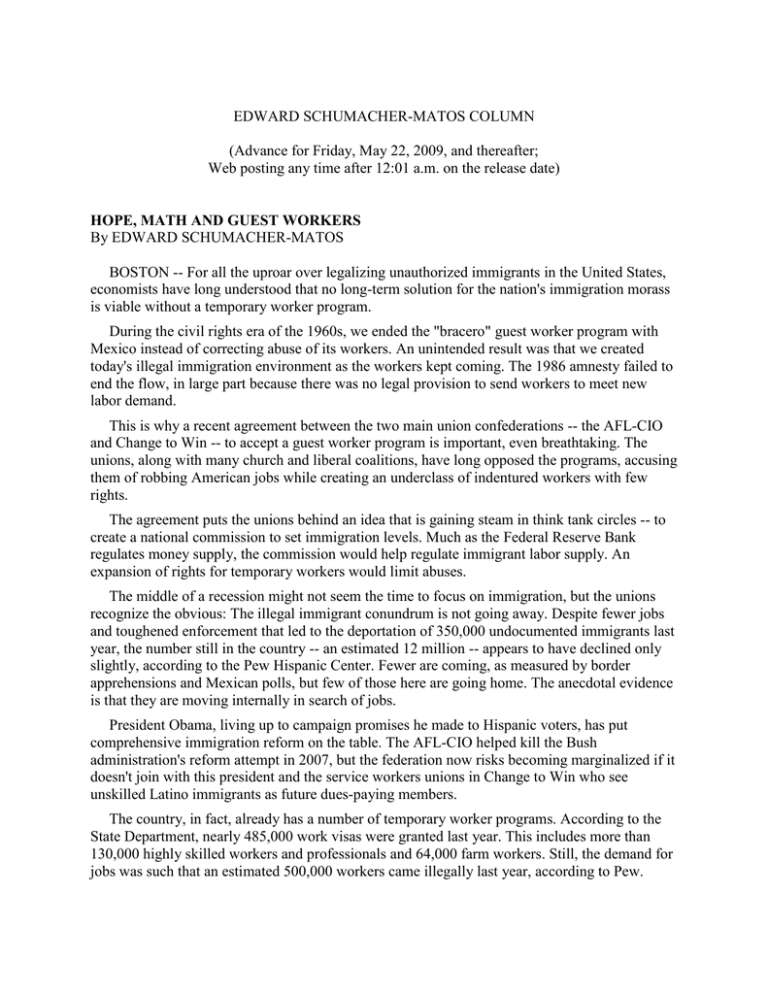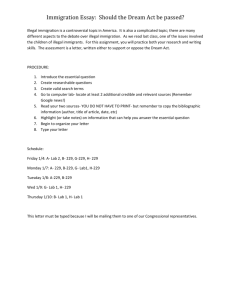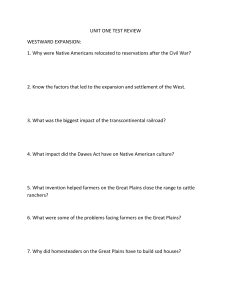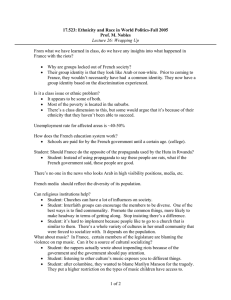EDWARD SCHUMACHER-MATOS COLUMN (Advance for Friday, May 22, 2009, and thereafter;
advertisement

EDWARD SCHUMACHER-MATOS COLUMN (Advance for Friday, May 22, 2009, and thereafter; Web posting any time after 12:01 a.m. on the release date) HOPE, MATH AND GUEST WORKERS By EDWARD SCHUMACHER-MATOS BOSTON -- For all the uproar over legalizing unauthorized immigrants in the United States, economists have long understood that no long-term solution for the nation's immigration morass is viable without a temporary worker program. During the civil rights era of the 1960s, we ended the "bracero" guest worker program with Mexico instead of correcting abuse of its workers. An unintended result was that we created today's illegal immigration environment as the workers kept coming. The 1986 amnesty failed to end the flow, in large part because there was no legal provision to send workers to meet new labor demand. This is why a recent agreement between the two main union confederations -- the AFL-CIO and Change to Win -- to accept a guest worker program is important, even breathtaking. The unions, along with many church and liberal coalitions, have long opposed the programs, accusing them of robbing American jobs while creating an underclass of indentured workers with few rights. The agreement puts the unions behind an idea that is gaining steam in think tank circles -- to create a national commission to set immigration levels. Much as the Federal Reserve Bank regulates money supply, the commission would help regulate immigrant labor supply. An expansion of rights for temporary workers would limit abuses. The middle of a recession might not seem the time to focus on immigration, but the unions recognize the obvious: The illegal immigrant conundrum is not going away. Despite fewer jobs and toughened enforcement that led to the deportation of 350,000 undocumented immigrants last year, the number still in the country -- an estimated 12 million -- appears to have declined only slightly, according to the Pew Hispanic Center. Fewer are coming, as measured by border apprehensions and Mexican polls, but few of those here are going home. The anecdotal evidence is that they are moving internally in search of jobs. President Obama, living up to campaign promises he made to Hispanic voters, has put comprehensive immigration reform on the table. The AFL-CIO helped kill the Bush administration's reform attempt in 2007, but the federation now risks becoming marginalized if it doesn't join with this president and the service workers unions in Change to Win who see unskilled Latino immigrants as future dues-paying members. The country, in fact, already has a number of temporary worker programs. According to the State Department, nearly 485,000 work visas were granted last year. This includes more than 130,000 highly skilled workers and professionals and 64,000 farm workers. Still, the demand for jobs was such that an estimated 500,000 workers came illegally last year, according to Pew. Once the recession ends, that number could return to what had been its running level of about 800,000 illegal immigrants entering a year. The effectiveness of tougher enforcement may prevent this, though hardly any expert believes enforcement alone will end illegal immigration. The idea of a commission to set realistic guest worker levels was first proposed three years ago by the bipartisan Migration Policy Institute. The MPI plan would have the commission make recommendations to Congress, while the union would require Congress to ratify commission rulings. Either way, a panel of experts reduces the politics used now to set levels. As the AFLCIO's Ana Avendano says: "Immigration is never looked at with a rational lens. We're taking the emotion out, with a numbers and math model." That said, brawls are sure to break out over picking the commission's members, setting the methodology and, later, lobbying before the commission. MPI favors a commission that includes representatives from Treasury, Commerce, Labor and other departments, and uses formulas that look at what is best for the nation's economy as a whole. The unions have not specified details, but the architect of their proposal, Ray Marshall, secretary of labor under Jimmy Carter, leans heavily in a recent work, "Immigration for Shared Prosperity," on Labor Department formulas. Fear of the Marshall proposal scares the U.S. Chamber of Commerce. Indeed, the government's labor databases are myopic and miss larger national and international economic trends. "At best, everything would rest upon who is appointed, a dangerous 'roll of the dice' for employers, immigrants and their families," the National Foundation for American Policy said in a brief. The chamber's objections would seem to be easy to resolve as negotiations unfold this year. Certainly, the union switch on the principle of temporary workers and on the commission holds out the best hope in decades to build an immigration system that is best for the country. It might even work. Edward Schumacher-Matos' e-mail address is edward.schumachermatos(at)yahoo.com. (c) 2009, The Washington Post Writers Group (See attached file: schu0520.txt)







